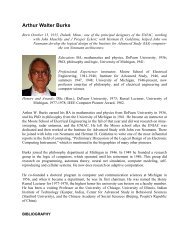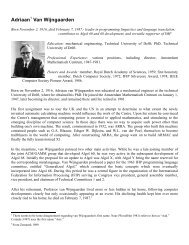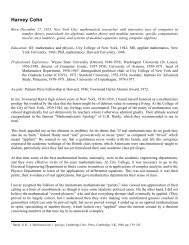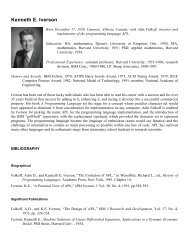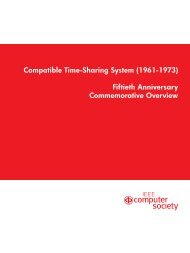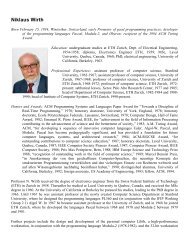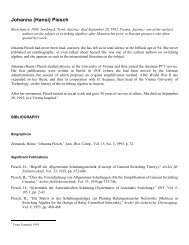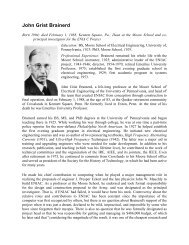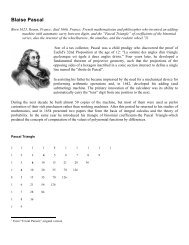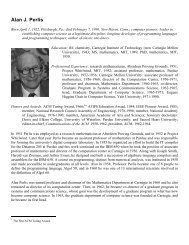John Vincent Atanasoff - Walden Family
John Vincent Atanasoff - Walden Family
John Vincent Atanasoff - Walden Family
You also want an ePaper? Increase the reach of your titles
YUMPU automatically turns print PDFs into web optimized ePapers that Google loves.
Clifford E. Berry and I were very pleased to have access to a method of computing with such power. Once our<br />
prototype had proved successful, we both knew that we could build a machine that could do almost anything in<br />
the way of computation.<br />
During the early years, our computer had a title relating to the solution of large systems of linear algebraic<br />
equations. About 1968, I became aware that it would be discussed at length, and, since Berry was dead, I<br />
wanted a title that would honor him for his extraordinary ability and effort in developing this computer.<br />
Accordingly, I renamed it the <strong>Atanasoff</strong> Berry Computer ... the ABC.<br />
In order to get started fast, I decided to take a chance and estimate the size of the machine. I knew a few<br />
dimensions of the various parts that were to go into it. I was repeatedly trying to estimate the number of vacuum<br />
tubes I would need for this digital electronic computer. Arbitrarily, we had decided that it would operate over 30<br />
fields, and so would require 30 add-subtract mechanisms. Without very much figuring, I made an estimate of<br />
the size of the total machine and arrived at roughly the size of an office desk. So, I ordered a lot of angle iron<br />
for the frame. People saw these irons at the back entrance of the physics building and wondered about them. I<br />
heard someone replying to a question, “Oh, <strong>Atanasoff</strong> thinks he is going to make a computer out of those angle<br />
irons.”<br />
At that time, the largest digital computer was the IBM tabulator. The one we had at Iowa State College could<br />
tabulate and sum 40 columns of the 80 that the punched card provided. But we knew there existed machines<br />
which could tabulate and add the full 80 columns, divided into ten fields of eight columns each.... We planned a<br />
machine of 3000 fields of memory, which would in fact calculate at a speed of about 30 times that of the largest<br />
IBM tabulator.<br />
When one starts a new and strange project, one must expect that it will be in financial trouble from the start. I<br />
had received some aid from Iowa State College, and expected and did receive more from time to time.<br />
However, I knew that I should seek some other source for the funds necessary to complete the computer project.<br />
In my requests to Iowa State College, I had used a two-page write-up, but in asking others for help, I needed<br />
something better. During the spring and summer of 1940, I used my spare time to write not only what we had<br />
done, but also what we proposed to do during the remainder of the project. This paper, finished on August 14,<br />
1940, has been reprinted by Brian Randell in his book The Origins of Digital Computers (1982).<br />
I felt that the work we were doing on computers should be patented, and so, at an early stage, I had investigated<br />
the subject of patents at Iowa State College. It seemed clear to me that there was no firm policy on the subject. I<br />
learned that the Iowa State College Research Foundation (ISCRF), whom I consulted concerning a patent<br />
application, did not regard their own patent counsel as adequate for this task. I was referred to Mr. Richard R.<br />
Trexler, a Chicago patent attorney. When ultimately ISCRF and I entered into a contract for the proceeds of a<br />
patent on my invention, they agreed, in principle at least, to use Mr. Trexler as our patent attorney.<br />
No official pronouncement was made on the terms of a contract, or even on the necessity for a contract, until<br />
Dr. Friley, president of Iowa State College, received the letter of March 24, 1941, from President Howard<br />
Poillon of Research Corporation granting $5330, a considerable amount of money in those days. Then, from a<br />
seeming absence of any policy, the situation changed drastically and Iowa State College policy was suddenly<br />
firm. I am still not exactly sure how it all came about, but I have since seen a letter from Dr. Friley to ISCRF<br />
saying that Iowa State College should hold onto rights to the patent on my invention. I very soon heard from






